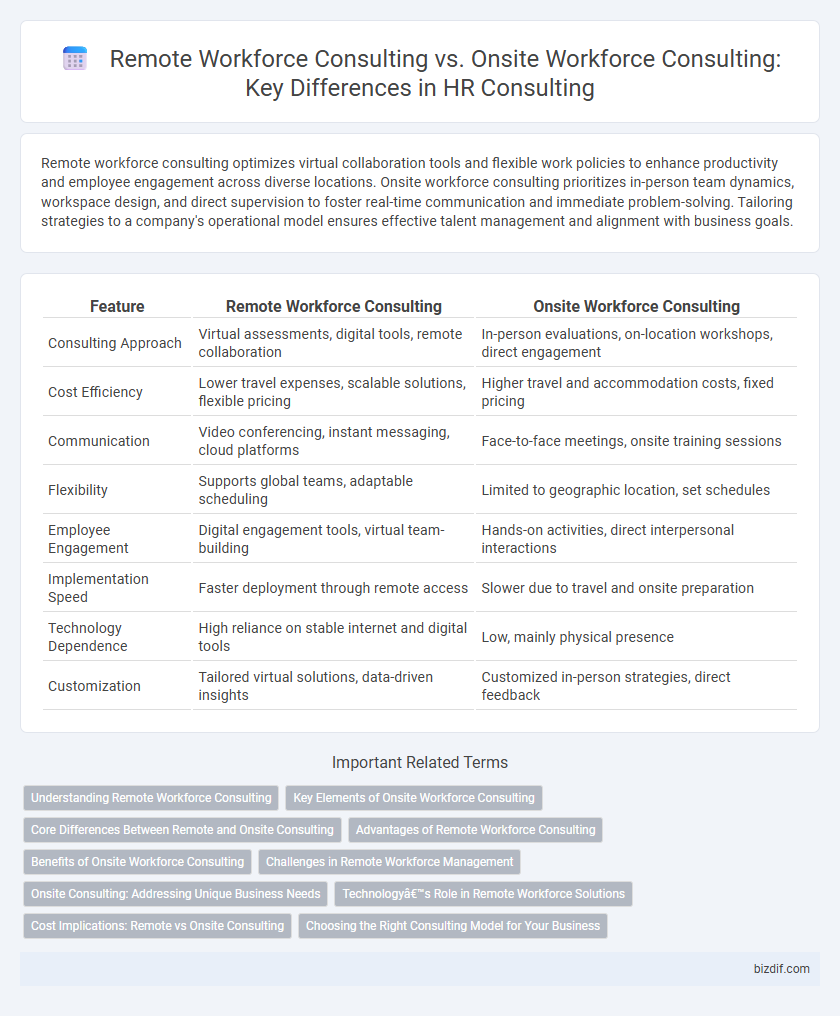Remote workforce consulting optimizes virtual collaboration tools and flexible work policies to enhance productivity and employee engagement across diverse locations. Onsite workforce consulting prioritizes in-person team dynamics, workspace design, and direct supervision to foster real-time communication and immediate problem-solving. Tailoring strategies to a company's operational model ensures effective talent management and alignment with business goals.
Table of Comparison
| Feature | Remote Workforce Consulting | Onsite Workforce Consulting |
|---|---|---|
| Consulting Approach | Virtual assessments, digital tools, remote collaboration | In-person evaluations, on-location workshops, direct engagement |
| Cost Efficiency | Lower travel expenses, scalable solutions, flexible pricing | Higher travel and accommodation costs, fixed pricing |
| Communication | Video conferencing, instant messaging, cloud platforms | Face-to-face meetings, onsite training sessions |
| Flexibility | Supports global teams, adaptable scheduling | Limited to geographic location, set schedules |
| Employee Engagement | Digital engagement tools, virtual team-building | Hands-on activities, direct interpersonal interactions |
| Implementation Speed | Faster deployment through remote access | Slower due to travel and onsite preparation |
| Technology Dependence | High reliance on stable internet and digital tools | Low, mainly physical presence |
| Customization | Tailored virtual solutions, data-driven insights | Customized in-person strategies, direct feedback |
Understanding Remote Workforce Consulting
Remote workforce consulting specializes in optimizing virtual team management by implementing effective communication strategies, technology integration, and performance monitoring tailored for dispersed employees. It focuses on addressing challenges unique to remote work, such as maintaining employee engagement, cybersecurity, and compliance with remote work policies. This consulting approach enhances productivity and fosters a cohesive organizational culture despite physical distance.
Key Elements of Onsite Workforce Consulting
Onsite Workforce Consulting emphasizes direct employee engagement, facility optimization, and real-time collaboration to boost productivity and organizational culture. Key elements include workplace layout analysis, employee interaction monitoring, and hands-on change management strategies that align with company goals. This approach leverages physical presence to foster team cohesion and swiftly address operational challenges.
Core Differences Between Remote and Onsite Consulting
Remote workforce consulting emphasizes digital collaboration tools, flexible communication methods, and virtual team engagement strategies, while onsite consulting prioritizes face-to-face interaction, direct supervision, and physical workspace optimization. Remote consulting relies heavily on technology to monitor productivity and employee well-being, contrasting with onsite approaches that leverage in-person dynamics for immediate problem-solving and team cohesion. The core difference lies in the mode of interaction and management techniques tailored to either virtual or physical work environments, impacting HR policies, employee training, and performance measurement.
Advantages of Remote Workforce Consulting
Remote workforce consulting offers enhanced flexibility and access to a global talent pool, enabling companies to scale efficiently without geographical limitations. It reduces overhead costs related to office space, utilities, and commuting, improving overall budget management. Advanced digital tools and cloud-based platforms facilitate seamless communication and collaboration, boosting productivity and employee satisfaction.
Benefits of Onsite Workforce Consulting
Onsite Workforce Consulting enhances team collaboration and communication by fostering face-to-face interactions that drive real-time problem-solving and innovation. It enables HR consultants to observe workplace dynamics directly, facilitating accurate assessments and tailored strategies that improve employee engagement and productivity. The physical presence of experts also supports immediate feedback and hands-on training, accelerating skill development and organizational change.
Challenges in Remote Workforce Management
Managing remote workforce presents challenges such as maintaining employee engagement, ensuring clear communication, and monitoring productivity without direct supervision. HR consulting addresses issues related to technology adoption, data security, and compliance with remote work policies. Onsite workforce consulting typically focuses on physical workspace optimization and face-to-face management, which are less emphasized in remote settings.
Onsite Consulting: Addressing Unique Business Needs
Onsite workforce consulting offers tailored solutions that directly address the unique operational challenges faced by businesses within their physical environment. By evaluating workplace dynamics, employee interactions, and facility-specific workflows, onsite consultants develop customized strategies that enhance productivity and optimize resource allocation. This hands-on approach ensures alignment with corporate culture and immediate responsiveness to organizational needs, driving sustained performance improvements.
Technology’s Role in Remote Workforce Solutions
Technology plays a pivotal role in remote workforce consulting by enabling seamless communication, collaboration, and productivity across dispersed teams through tools like video conferencing, cloud-based project management, and virtual private networks (VPNs). Advanced analytics and artificial intelligence enhance employee monitoring and performance evaluation, ensuring remote teams align with organizational goals. In contrast, onsite workforce consulting leverages technology primarily for operational efficiency and infrastructure management within a centralized office environment.
Cost Implications: Remote vs Onsite Consulting
Remote workforce consulting significantly reduces overhead costs related to office space, utilities, and commuting expenses, allowing HR firms to allocate budget more efficiently toward technology and employee engagement tools. Onsite workforce consulting often incurs higher travel, accommodation, and daily operational costs, impacting overall project budgets and client pricing structures. Evaluating these cost implications helps organizations optimize HR consulting investments based on workforce distribution and strategic priorities.
Choosing the Right Consulting Model for Your Business
Choosing the right consulting model for your business hinges on understanding the unique needs of your workforce and operational goals. Remote workforce consulting offers expertise in virtual team management, digital collaboration tools, and flexible work policies, ideal for companies aiming to enhance productivity without geographical constraints. Onsite workforce consulting focuses on in-person engagement, organizational culture, and hands-on training, suitable for businesses that prioritize direct supervision and immediate employee interaction.
Remote Workforce Consulting vs Onsite Workforce Consulting Infographic

 bizdif.com
bizdif.com